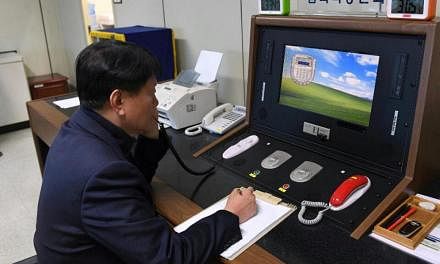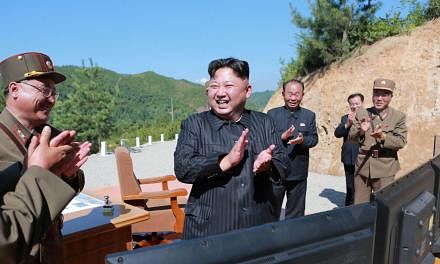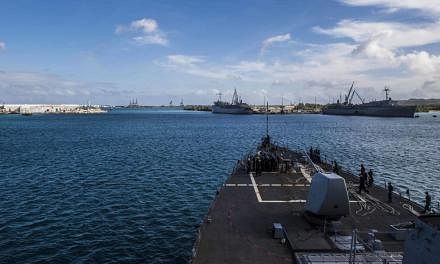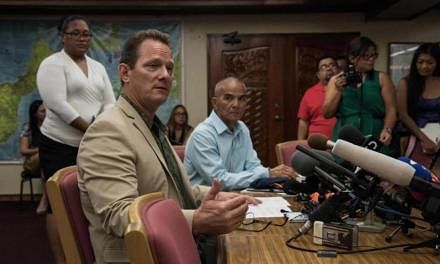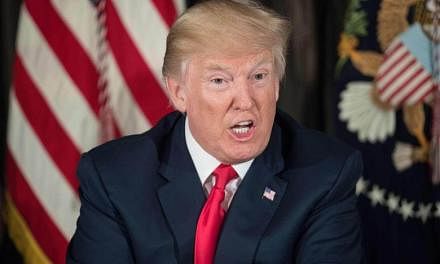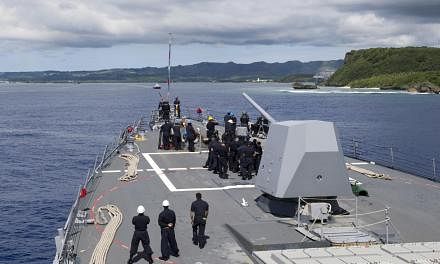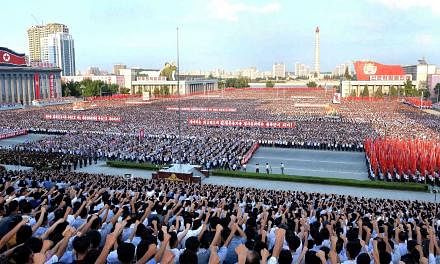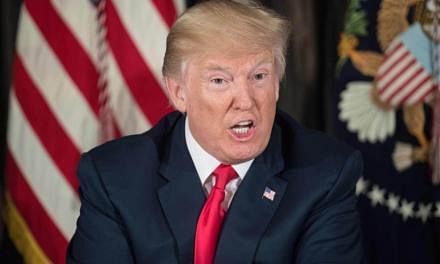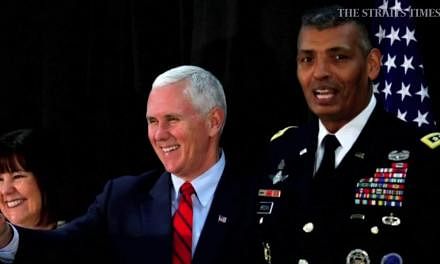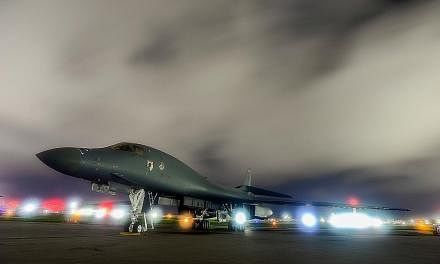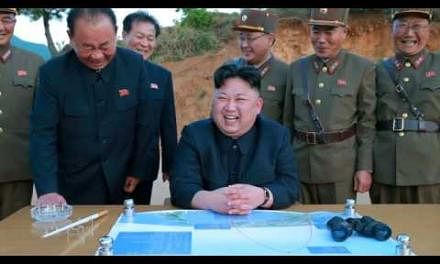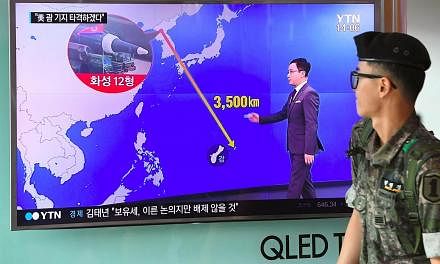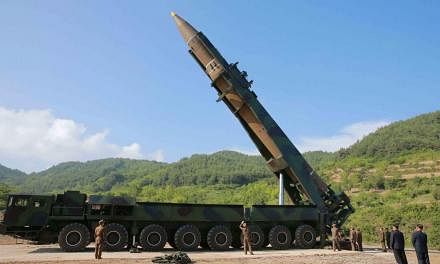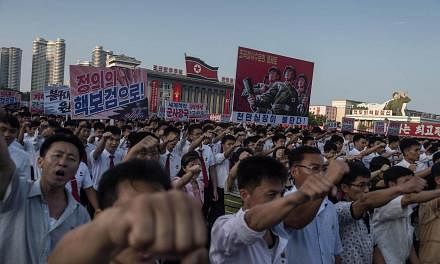SEOUL (AFP/REUTERS) - North Korea's leader has delayed a decision on firing missiles towards Guam while he watches US actions a little longer, the North's state media said on Tuesday, (Aug 15) as South Korea's president said Seoul would seek to prevent war by all means.
Signs of easing in tensions on the Korean peninsula helped stock markets rally for a second day running even as the United States and South Korea prepared for more joint military drills and experts warned North Korea could still proceed with its provocative plan.
In his first public appearance in about two weeks, North Korean leader Kim Jong Un inspected the command of the North's army on Monday, examining a plan to fire four missiles to land near the US Pacific territory of Guam, the official KCNA said in a report.
"He said that if the Yankees persist in their extremely dangerous reckless actions on the Korean peninsula and in its vicinity, testing the self-restraint of the DPRK, the latter will make an important decision as it already declared," the report said.
The DPRK stands for North Korea's official name, the Democratic People's Republic of Korea.
Some analysts suggested Kim's comments in his first public appearance in two weeks opened a possible path to de-escalating a growing crisis fuelled by a bellicose war of words between US President Donald Trump and the North Korean leadership.
John Delury of Yonsei University in Seoul said Kim was "de-escalating, putting Guam plan on ice" - at least for now. "We are not out of the woods. Both sides need to keep taking steps to de-escalate in words and deed. Diplomacy needs to go in high gear," he added.
On Guam, home to a U.S. air base, a Navy installation, a Coast Guard group and roughly 6,000 U.S. military personnel, residents expressed some relief at the lessening of tensions.
"I'm reading between the lines that I don't see an imminent threat," Guam Lieutenant Governor Ray Tenorio told a media briefing in the island's capital of Hagatna.
But, as is often the case with North Korea, the message was mixed: Kim was inspecting the missile unit tasked with preparing to strike near Guam, and photos released by state media showed a large satellite image of Andersen Air Force Base on Guam on the screen beside the leader, reported Washington Post.
In photos released with the KCNA report, Kim was seen holding a baton and pointing at a map showing a flight path for the missiles appearing to start from North Korea's east coast, flying over Japan towards Guam.
North Korea has often threatened to attack the United States and its bases and released similar photos in the past but never followed through.
Professor Kim Dong Yub, a professor and a military expert at Kyungnam University's Institute of Far Eastern Studies in Seoul urged caution in assuming North Korea was bluffing with its missile threats.
"There is no stepping back for North Korea. Those who don't know the North very well fall into this trap every time (thinking they are easing threats) but we've seen this before."
The US and South Korea remain technically still at war with North Korea after the 1950-53 Korean conflict ended with a truce, not a peace treaty.
Pyongyang's plans to fire missiles near Guam prompted a surge in tensions in the region last week, with US President Donald Trump saying the US military was "locked and loaded" if North Korea acted unwisely.
South Korean President Moon Jae In said on Tuesday there would be no military action without Seoul's consent and his government would prevent war by all means.
"Military action on the Korean peninsula can only be decided by South Korea and no one else can decide to take military action without the consent of South Korea," Moon said in a speech to commemorate the anniversary of the nation's liberation from Japanese military rule in 1945.
"The government, putting everything on the line, will block war by all means," Moon said.
In a telephone call on Tuesday, Japanese prime minister Shinzo Abe also agree with US President Donald Trump that their top priority regarding North Korea was to do what they could to halt missile launches by the regime.
Japan, which would be under the flight path of any missile fired towards Guam, will be seeking further reassurance from Washington in meetings between Japan's defence chief and foreign minister and their U.S. counterparts on Thursday.
"The strategic environment is becoming harsher and we need to discuss how we will respond to that," a Japanese foreign ministry official said in a briefing in Tokyo. "We will look for the U.S. to reaffirm it defence commitment, including the nuclear deterrent," he added.
China meantime reiterated calls for restraint on the Korean peninsula, saying it hoped all sides could put out the flames, not add oil to the fire with their words and actions.
Speaking at a daily press briefing in Beijing on Tuesday, Foreign Ministry spokesman Hua Chunying urged a peaceful resolution of the standoff.
North Korea's military said last week that it would finalise by mid-August its detailed plan to test-fire four intermediate-range ballistic missiles in an "enveloping fire" around Guam and report it to its leader for approval.
The North's plan is to launch four missiles into the waters around the US Pacific territory of Guam: one to the north, one to the south, and one each east and west. Pyongyang is calling it an "enveloping fire" demonstration, but in military jargon it's more commonly called "bracketing". It was calculated to touch off a storm of anxiety region-wide.
But firing missiles into Guam's exclusive economic zone, as the North threatened, would be an extremely risky move, according to the Associated Press in an analysis piece.
"If they fire at the United States, it could escalate into war very quickly," US Defense Secretary James Mattis said on Monday. "Yes, that's called war, if they shoot at us."
Mattis was vague about what would happen if missiles were launched towards Guam but splashed into the sea, reported Bloomberg.
Tensions have been mounting since the North tested two intercontinental ballistic missile tests last month, which appeared to bring much of the US within range.
Responding to the tests, US President Trump warned Pyongyang of "fire and fury like the world has never seen". The North in turn threatened to test-fire its missiles towards the US Pacific island of Guam.
The war of words has sparked global alarm, with world leaders including Chinese President Xi Jinping urging calm on both sides. South Korean President Moon on Monday called for calm, saying there should never be another war on the peninsula.



